HI6028 Taxation Theory, Practice & Law: Individual Assignment Analysis
VerifiedAdded on 2023/06/04
|13
|3156
|88
Homework Assignment
AI Summary
This assignment solution analyzes the taxation implications of various asset sales and fringe benefits. Question 1 examines capital gains tax (CGT) for an investor who is not carrying on a business, focusing on pre-CGT assets, capital events, cost base calculations, the 50% discount on capital gains, and the adjustment of capital losses. The analysis includes the sale of vacant land, an antique bed, a painting, shares, and a violin, determining CGT liabilities for each. Question 2 delves into fringe benefits tax (FBT), specifically car fringe benefits and loan fringe benefits provided to an employee by their employer, Rapid Heat. It calculates FBT liabilities, considering the car's cost base, usage period, and applicable FBT rates, along with loan fringe benefit implications. The solution provides detailed calculations and explanations based on Australian tax law.

Taxation Theory, Practice & Law
STUDENT NAME/ID
[Pick the date]
STUDENT NAME/ID
[Pick the date]
Paraphrase This Document
Need a fresh take? Get an instant paraphrase of this document with our AI Paraphraser

Question 1
In the current situation, the taxpayer has sold some of his assets during the income tax year
2017/18 which needs to be discussed for taxation treatment. Further, the taxpayer is not running
a business of the given assets and hence, the objective is not to treat the sale proceed as
assessable income of the taxpayer because the client would have capital gains/loss which would
then be analysed to comment on the Capital Gains Tax (CGT) implications. The main factors
which need to be analysed for the validity of the CGT on the received capital gains are
represented below.
Factor 1: PRE-CGT ASSET
As the name suggests, the assets which are acquired before the enactment of CGT are considered
as pre-CGT assets. The enactment of CGT has been done on September 20, 1985 which means
any asset of the taxpayer which he/she has acquired prior to this date would be recognised as pre-
CGT asset. When any pre-CGT asset is liquidated by the taxpayer, then the respective taxpayer
who has received capital gains/losses would not liable for CGT implication as evident from
s.140-10, ITAA 1997 (Austlii, 2018 c).
Factor 2: CAPITAL EVENT
When there is a disposal of capital assets then there would be capital gains or losses which need
to be computed. The summary of various CGT events is highlighted in s. 104-5, ITAA 1997
(Sadiq, et.al., 2015). Based on the current scenario, the transactions of disposal of assets belong
to A1 event which includes that capital gains or losses would be determined when the cost base
of the respective capital asset would be deducted from the received sale proceeds. Capital
proceed is normal amount which the taxpayer has earned from the buyer party after selling
his/her capital assets. However, the cost base of the asset involves five elements which are
essential to determine (Wilmot, 2014).
Factor 3: COST BASE OF ASSET
The relevant provision is discussed in s. 110-25, ITAA 1997 which shows the key costs/expenses
which may be borne by the concerned taxpayer for the asset. All the respective costs under cost
1
In the current situation, the taxpayer has sold some of his assets during the income tax year
2017/18 which needs to be discussed for taxation treatment. Further, the taxpayer is not running
a business of the given assets and hence, the objective is not to treat the sale proceed as
assessable income of the taxpayer because the client would have capital gains/loss which would
then be analysed to comment on the Capital Gains Tax (CGT) implications. The main factors
which need to be analysed for the validity of the CGT on the received capital gains are
represented below.
Factor 1: PRE-CGT ASSET
As the name suggests, the assets which are acquired before the enactment of CGT are considered
as pre-CGT assets. The enactment of CGT has been done on September 20, 1985 which means
any asset of the taxpayer which he/she has acquired prior to this date would be recognised as pre-
CGT asset. When any pre-CGT asset is liquidated by the taxpayer, then the respective taxpayer
who has received capital gains/losses would not liable for CGT implication as evident from
s.140-10, ITAA 1997 (Austlii, 2018 c).
Factor 2: CAPITAL EVENT
When there is a disposal of capital assets then there would be capital gains or losses which need
to be computed. The summary of various CGT events is highlighted in s. 104-5, ITAA 1997
(Sadiq, et.al., 2015). Based on the current scenario, the transactions of disposal of assets belong
to A1 event which includes that capital gains or losses would be determined when the cost base
of the respective capital asset would be deducted from the received sale proceeds. Capital
proceed is normal amount which the taxpayer has earned from the buyer party after selling
his/her capital assets. However, the cost base of the asset involves five elements which are
essential to determine (Wilmot, 2014).
Factor 3: COST BASE OF ASSET
The relevant provision is discussed in s. 110-25, ITAA 1997 which shows the key costs/expenses
which may be borne by the concerned taxpayer for the asset. All the respective costs under cost
1
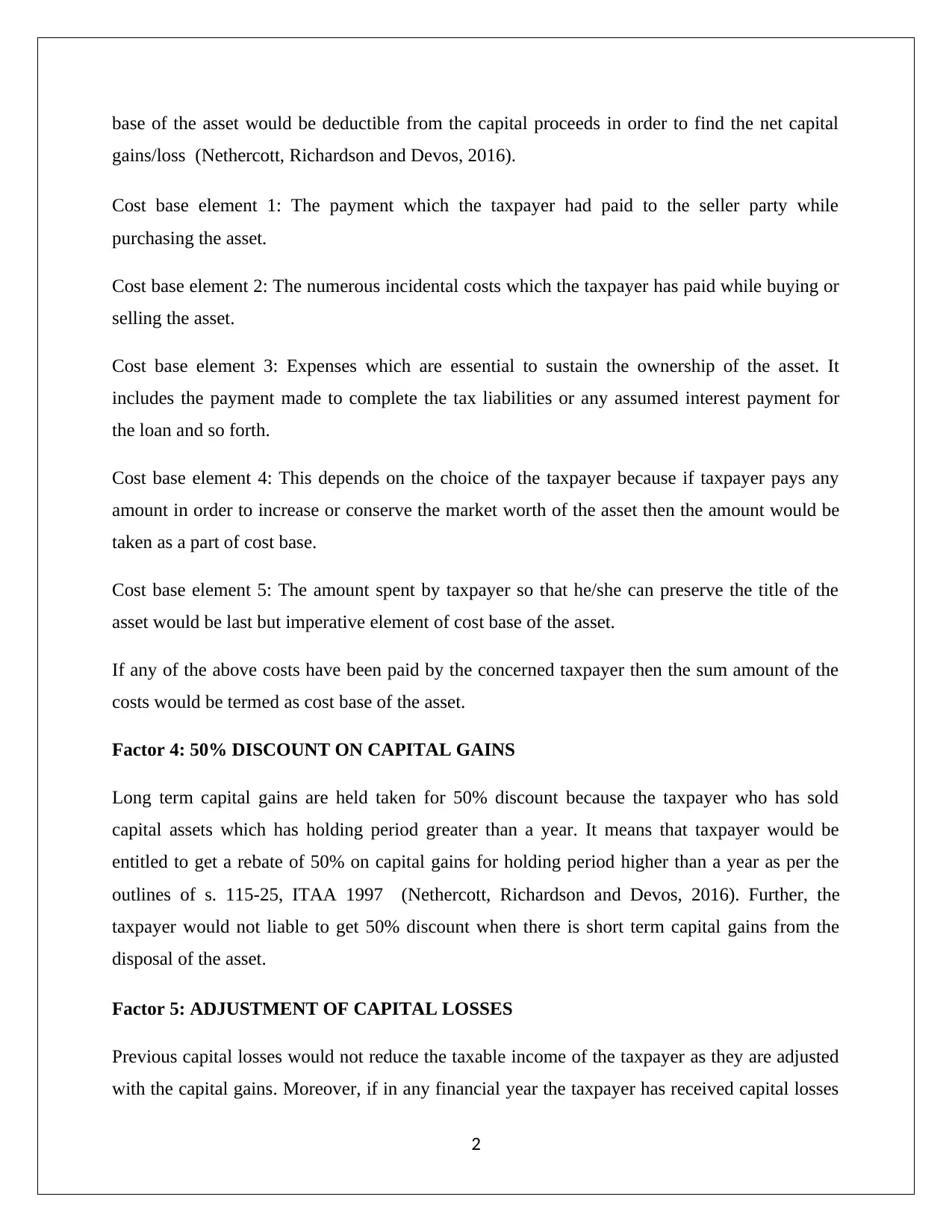
base of the asset would be deductible from the capital proceeds in order to find the net capital
gains/loss (Nethercott, Richardson and Devos, 2016).
Cost base element 1: The payment which the taxpayer had paid to the seller party while
purchasing the asset.
Cost base element 2: The numerous incidental costs which the taxpayer has paid while buying or
selling the asset.
Cost base element 3: Expenses which are essential to sustain the ownership of the asset. It
includes the payment made to complete the tax liabilities or any assumed interest payment for
the loan and so forth.
Cost base element 4: This depends on the choice of the taxpayer because if taxpayer pays any
amount in order to increase or conserve the market worth of the asset then the amount would be
taken as a part of cost base.
Cost base element 5: The amount spent by taxpayer so that he/she can preserve the title of the
asset would be last but imperative element of cost base of the asset.
If any of the above costs have been paid by the concerned taxpayer then the sum amount of the
costs would be termed as cost base of the asset.
Factor 4: 50% DISCOUNT ON CAPITAL GAINS
Long term capital gains are held taken for 50% discount because the taxpayer who has sold
capital assets which has holding period greater than a year. It means that taxpayer would be
entitled to get a rebate of 50% on capital gains for holding period higher than a year as per the
outlines of s. 115-25, ITAA 1997 (Nethercott, Richardson and Devos, 2016). Further, the
taxpayer would not liable to get 50% discount when there is short term capital gains from the
disposal of the asset.
Factor 5: ADJUSTMENT OF CAPITAL LOSSES
Previous capital losses would not reduce the taxable income of the taxpayer as they are adjusted
with the capital gains. Moreover, if in any financial year the taxpayer has received capital losses
2
gains/loss (Nethercott, Richardson and Devos, 2016).
Cost base element 1: The payment which the taxpayer had paid to the seller party while
purchasing the asset.
Cost base element 2: The numerous incidental costs which the taxpayer has paid while buying or
selling the asset.
Cost base element 3: Expenses which are essential to sustain the ownership of the asset. It
includes the payment made to complete the tax liabilities or any assumed interest payment for
the loan and so forth.
Cost base element 4: This depends on the choice of the taxpayer because if taxpayer pays any
amount in order to increase or conserve the market worth of the asset then the amount would be
taken as a part of cost base.
Cost base element 5: The amount spent by taxpayer so that he/she can preserve the title of the
asset would be last but imperative element of cost base of the asset.
If any of the above costs have been paid by the concerned taxpayer then the sum amount of the
costs would be termed as cost base of the asset.
Factor 4: 50% DISCOUNT ON CAPITAL GAINS
Long term capital gains are held taken for 50% discount because the taxpayer who has sold
capital assets which has holding period greater than a year. It means that taxpayer would be
entitled to get a rebate of 50% on capital gains for holding period higher than a year as per the
outlines of s. 115-25, ITAA 1997 (Nethercott, Richardson and Devos, 2016). Further, the
taxpayer would not liable to get 50% discount when there is short term capital gains from the
disposal of the asset.
Factor 5: ADJUSTMENT OF CAPITAL LOSSES
Previous capital losses would not reduce the taxable income of the taxpayer as they are adjusted
with the capital gains. Moreover, if in any financial year the taxpayer has received capital losses
2
⊘ This is a preview!⊘
Do you want full access?
Subscribe today to unlock all pages.

Trusted by 1+ million students worldwide
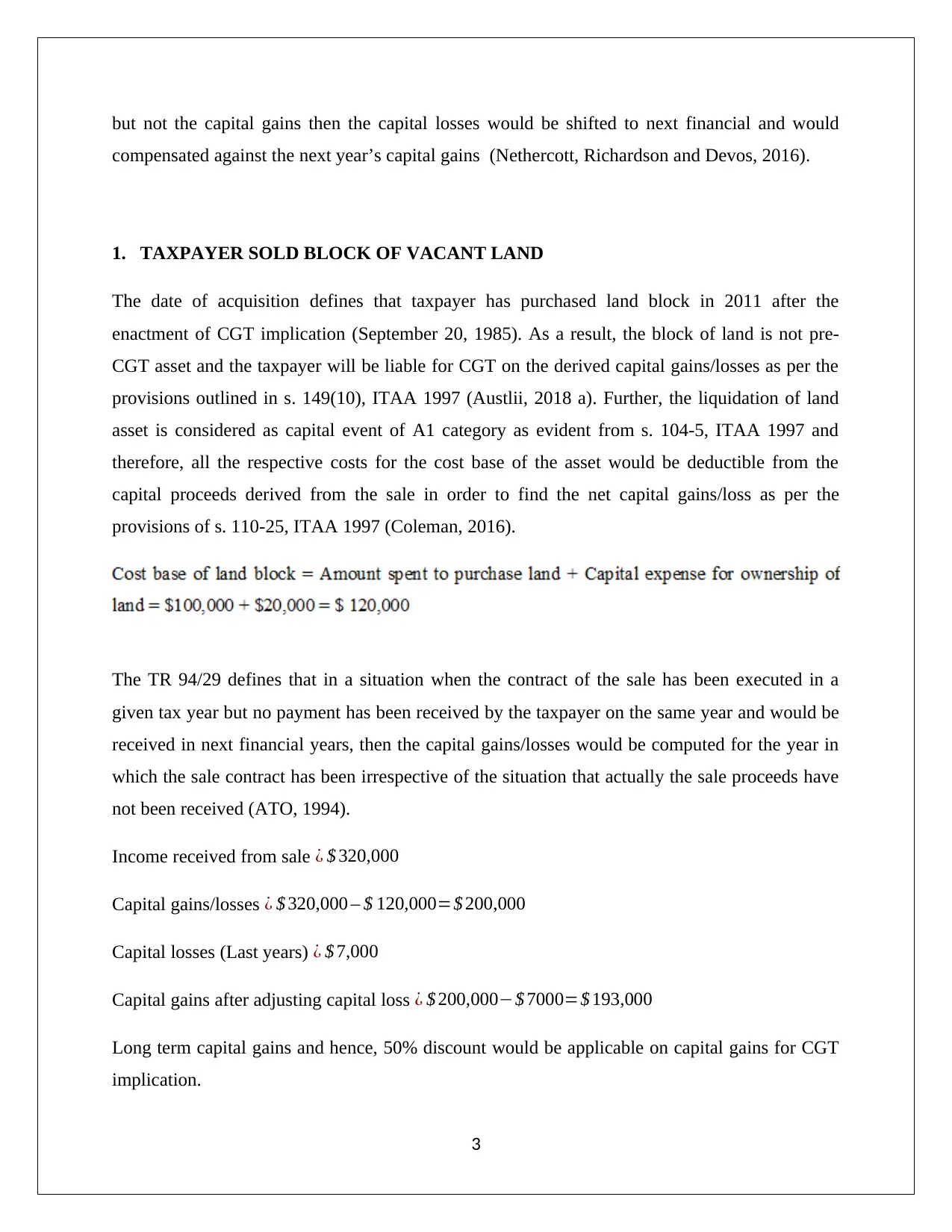
but not the capital gains then the capital losses would be shifted to next financial and would
compensated against the next year’s capital gains (Nethercott, Richardson and Devos, 2016).
1. TAXPAYER SOLD BLOCK OF VACANT LAND
The date of acquisition defines that taxpayer has purchased land block in 2011 after the
enactment of CGT implication (September 20, 1985). As a result, the block of land is not pre-
CGT asset and the taxpayer will be liable for CGT on the derived capital gains/losses as per the
provisions outlined in s. 149(10), ITAA 1997 (Austlii, 2018 a). Further, the liquidation of land
asset is considered as capital event of A1 category as evident from s. 104-5, ITAA 1997 and
therefore, all the respective costs for the cost base of the asset would be deductible from the
capital proceeds derived from the sale in order to find the net capital gains/loss as per the
provisions of s. 110-25, ITAA 1997 (Coleman, 2016).
The TR 94/29 defines that in a situation when the contract of the sale has been executed in a
given tax year but no payment has been received by the taxpayer on the same year and would be
received in next financial years, then the capital gains/losses would be computed for the year in
which the sale contract has been irrespective of the situation that actually the sale proceeds have
not been received (ATO, 1994).
Income received from sale ¿ $ 320,000
Capital gains/losses ¿ $ 320,000 – $ 120,000=$ 200,000
Capital losses (Last years) ¿ $ 7,000
Capital gains after adjusting capital loss ¿ $ 200,000−$ 7000=$ 193,000
Long term capital gains and hence, 50% discount would be applicable on capital gains for CGT
implication.
3
compensated against the next year’s capital gains (Nethercott, Richardson and Devos, 2016).
1. TAXPAYER SOLD BLOCK OF VACANT LAND
The date of acquisition defines that taxpayer has purchased land block in 2011 after the
enactment of CGT implication (September 20, 1985). As a result, the block of land is not pre-
CGT asset and the taxpayer will be liable for CGT on the derived capital gains/losses as per the
provisions outlined in s. 149(10), ITAA 1997 (Austlii, 2018 a). Further, the liquidation of land
asset is considered as capital event of A1 category as evident from s. 104-5, ITAA 1997 and
therefore, all the respective costs for the cost base of the asset would be deductible from the
capital proceeds derived from the sale in order to find the net capital gains/loss as per the
provisions of s. 110-25, ITAA 1997 (Coleman, 2016).
The TR 94/29 defines that in a situation when the contract of the sale has been executed in a
given tax year but no payment has been received by the taxpayer on the same year and would be
received in next financial years, then the capital gains/losses would be computed for the year in
which the sale contract has been irrespective of the situation that actually the sale proceeds have
not been received (ATO, 1994).
Income received from sale ¿ $ 320,000
Capital gains/losses ¿ $ 320,000 – $ 120,000=$ 200,000
Capital losses (Last years) ¿ $ 7,000
Capital gains after adjusting capital loss ¿ $ 200,000−$ 7000=$ 193,000
Long term capital gains and hence, 50% discount would be applicable on capital gains for CGT
implication.
3
Paraphrase This Document
Need a fresh take? Get an instant paraphrase of this document with our AI Paraphraser

Capital gains ¿ 50 %∗$ 193,000=$ 96,500
2. TAXPAYER SOLD ANTIQUE BED
The date of acquisition defines that taxpayer has purchased antique bed on July 21, 1986 after
the enactment of CGT implication (September 20, 1985). As a result, the bed is not pre-CGT
asset and the taxpayer will be liable for CGT on the derived capital gains/losses as per the
provisions outlined in s. 149(10), ITAA 1997 (Nethercott, Richardson and Devos, 2016).
Further, the liquidation of antique bed which is categorised as collectable is considered as capital
event of A1 category as evident from s. 104-5, ITAA 1997 and therefore, the respective costs
associated with the asset would be deductible from the capital proceeds derived from the sale so
as to find the net capital gains/loss as per the provisions of s. 110-25, ITAA 1997 (Coleman,
2016). Further, the requisite condition for the implication of the CGT is that the antique item
must be bought for higher than $500. Here, bed is purchased for $3,500 and hence, the requisite
condition is met and thus, CGT would be imposed.
Buying cost of the bed on July 21, 1986 ¿ $ 3,500
Taxpayer pays capital expenses in order to increase the market worth of the asset ¿ $ 1,500
Cost base ¿ $ 3500+$ 1500=$ 5,000
The taxpayer did not liquidate the bed rather the bed had been stolen and hence, the proceeds
from disposed asset would be the amount received from the insurance claim = $11,000
Capital gains ¿ $ 11,000−$ 5,000=$ 6,000
Capital losses (Last years) ¿ $ 1,500
Capital gains after adjusting capital loss ¿ $ 6,000−$ 1,500=$ 4,500
Long term capital gains and hence, 50% discount would be applicable on capital gains for CGT
implication.
Capital gains ¿ 50 %∗$ 4500=$ 2,250
4
2. TAXPAYER SOLD ANTIQUE BED
The date of acquisition defines that taxpayer has purchased antique bed on July 21, 1986 after
the enactment of CGT implication (September 20, 1985). As a result, the bed is not pre-CGT
asset and the taxpayer will be liable for CGT on the derived capital gains/losses as per the
provisions outlined in s. 149(10), ITAA 1997 (Nethercott, Richardson and Devos, 2016).
Further, the liquidation of antique bed which is categorised as collectable is considered as capital
event of A1 category as evident from s. 104-5, ITAA 1997 and therefore, the respective costs
associated with the asset would be deductible from the capital proceeds derived from the sale so
as to find the net capital gains/loss as per the provisions of s. 110-25, ITAA 1997 (Coleman,
2016). Further, the requisite condition for the implication of the CGT is that the antique item
must be bought for higher than $500. Here, bed is purchased for $3,500 and hence, the requisite
condition is met and thus, CGT would be imposed.
Buying cost of the bed on July 21, 1986 ¿ $ 3,500
Taxpayer pays capital expenses in order to increase the market worth of the asset ¿ $ 1,500
Cost base ¿ $ 3500+$ 1500=$ 5,000
The taxpayer did not liquidate the bed rather the bed had been stolen and hence, the proceeds
from disposed asset would be the amount received from the insurance claim = $11,000
Capital gains ¿ $ 11,000−$ 5,000=$ 6,000
Capital losses (Last years) ¿ $ 1,500
Capital gains after adjusting capital loss ¿ $ 6,000−$ 1,500=$ 4,500
Long term capital gains and hence, 50% discount would be applicable on capital gains for CGT
implication.
Capital gains ¿ 50 %∗$ 4500=$ 2,250
4
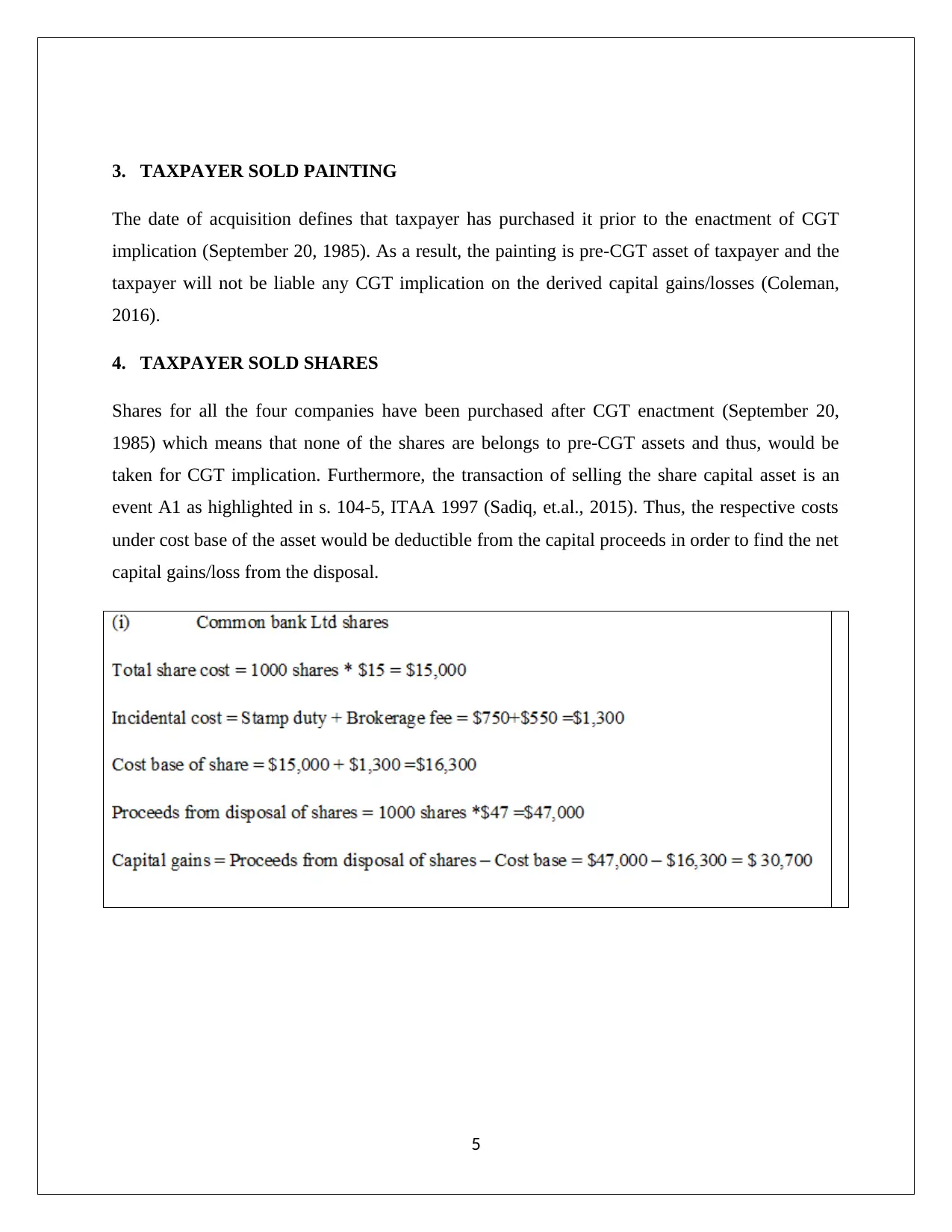
3. TAXPAYER SOLD PAINTING
The date of acquisition defines that taxpayer has purchased it prior to the enactment of CGT
implication (September 20, 1985). As a result, the painting is pre-CGT asset of taxpayer and the
taxpayer will not be liable any CGT implication on the derived capital gains/losses (Coleman,
2016).
4. TAXPAYER SOLD SHARES
Shares for all the four companies have been purchased after CGT enactment (September 20,
1985) which means that none of the shares are belongs to pre-CGT assets and thus, would be
taken for CGT implication. Furthermore, the transaction of selling the share capital asset is an
event A1 as highlighted in s. 104-5, ITAA 1997 (Sadiq, et.al., 2015). Thus, the respective costs
under cost base of the asset would be deductible from the capital proceeds in order to find the net
capital gains/loss from the disposal.
5
The date of acquisition defines that taxpayer has purchased it prior to the enactment of CGT
implication (September 20, 1985). As a result, the painting is pre-CGT asset of taxpayer and the
taxpayer will not be liable any CGT implication on the derived capital gains/losses (Coleman,
2016).
4. TAXPAYER SOLD SHARES
Shares for all the four companies have been purchased after CGT enactment (September 20,
1985) which means that none of the shares are belongs to pre-CGT assets and thus, would be
taken for CGT implication. Furthermore, the transaction of selling the share capital asset is an
event A1 as highlighted in s. 104-5, ITAA 1997 (Sadiq, et.al., 2015). Thus, the respective costs
under cost base of the asset would be deductible from the capital proceeds in order to find the net
capital gains/loss from the disposal.
5
⊘ This is a preview!⊘
Do you want full access?
Subscribe today to unlock all pages.

Trusted by 1+ million students worldwide
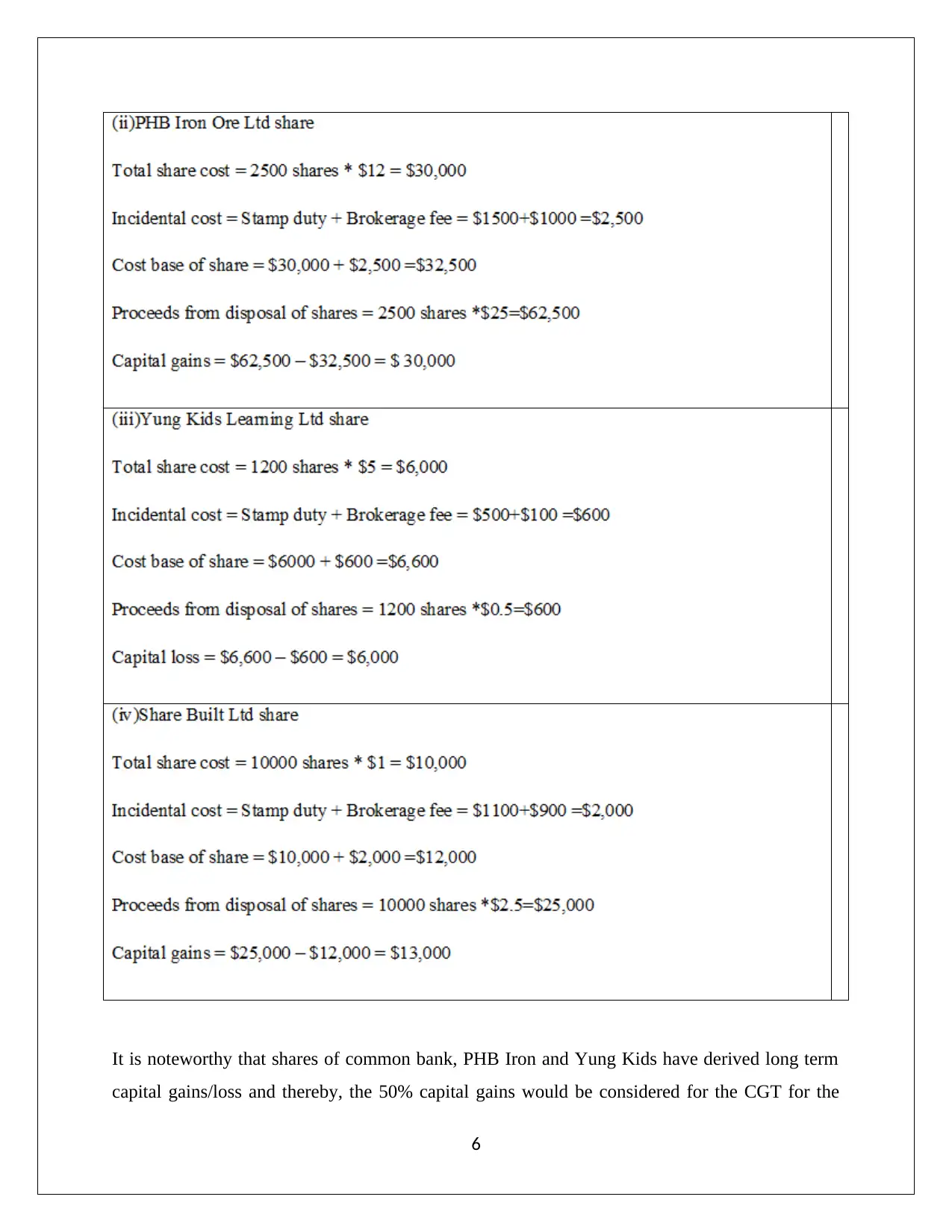
It is noteworthy that shares of common bank, PHB Iron and Yung Kids have derived long term
capital gains/loss and thereby, the 50% capital gains would be considered for the CGT for the
6
capital gains/loss and thereby, the 50% capital gains would be considered for the CGT for the
6
Paraphrase This Document
Need a fresh take? Get an instant paraphrase of this document with our AI Paraphraser
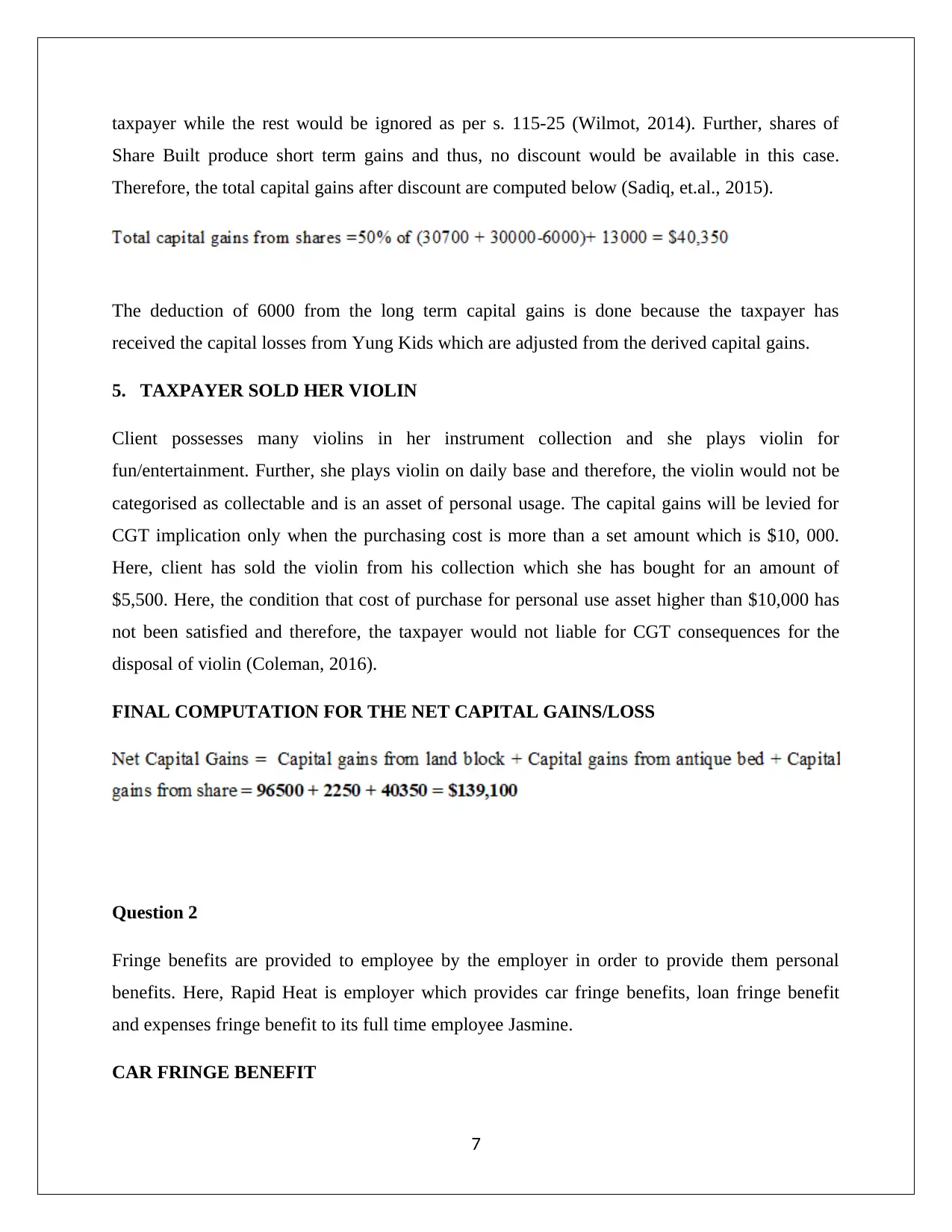
taxpayer while the rest would be ignored as per s. 115-25 (Wilmot, 2014). Further, shares of
Share Built produce short term gains and thus, no discount would be available in this case.
Therefore, the total capital gains after discount are computed below (Sadiq, et.al., 2015).
The deduction of 6000 from the long term capital gains is done because the taxpayer has
received the capital losses from Yung Kids which are adjusted from the derived capital gains.
5. TAXPAYER SOLD HER VIOLIN
Client possesses many violins in her instrument collection and she plays violin for
fun/entertainment. Further, she plays violin on daily base and therefore, the violin would not be
categorised as collectable and is an asset of personal usage. The capital gains will be levied for
CGT implication only when the purchasing cost is more than a set amount which is $10, 000.
Here, client has sold the violin from his collection which she has bought for an amount of
$5,500. Here, the condition that cost of purchase for personal use asset higher than $10,000 has
not been satisfied and therefore, the taxpayer would not liable for CGT consequences for the
disposal of violin (Coleman, 2016).
FINAL COMPUTATION FOR THE NET CAPITAL GAINS/LOSS
Question 2
Fringe benefits are provided to employee by the employer in order to provide them personal
benefits. Here, Rapid Heat is employer which provides car fringe benefits, loan fringe benefit
and expenses fringe benefit to its full time employee Jasmine.
CAR FRINGE BENEFIT
7
Share Built produce short term gains and thus, no discount would be available in this case.
Therefore, the total capital gains after discount are computed below (Sadiq, et.al., 2015).
The deduction of 6000 from the long term capital gains is done because the taxpayer has
received the capital losses from Yung Kids which are adjusted from the derived capital gains.
5. TAXPAYER SOLD HER VIOLIN
Client possesses many violins in her instrument collection and she plays violin for
fun/entertainment. Further, she plays violin on daily base and therefore, the violin would not be
categorised as collectable and is an asset of personal usage. The capital gains will be levied for
CGT implication only when the purchasing cost is more than a set amount which is $10, 000.
Here, client has sold the violin from his collection which she has bought for an amount of
$5,500. Here, the condition that cost of purchase for personal use asset higher than $10,000 has
not been satisfied and therefore, the taxpayer would not liable for CGT consequences for the
disposal of violin (Coleman, 2016).
FINAL COMPUTATION FOR THE NET CAPITAL GAINS/LOSS
Question 2
Fringe benefits are provided to employee by the employer in order to provide them personal
benefits. Here, Rapid Heat is employer which provides car fringe benefits, loan fringe benefit
and expenses fringe benefit to its full time employee Jasmine.
CAR FRINGE BENEFIT
7

Employer makes an extension of an owned car to employee that he/she can access for personal
purposes, then car fringe benefit is given by employer (s. 7 FBTAA 1986). Providing car for
personal use will raise the Fringe Benefit Tax liability (FBT liability) on employer not on
employee (Hodgson,Mortimer and Butler, 2016). Based on the current circumstances, it can be
viewed that Jasmine receives a car from Rapid Heat as car fringe benefits because the usage of
car is not restricted for professional work. It implies that Jasmine can use car for her own work
and take with her. Cost base of the car after balancing the minor repairs cost paid on behalf of the
employer for the employee. The period of usage will be the part of total days of availability of
days for the car. No deduction can be made when the car is out for minor repairing and when the
car is parked at the premises and client has out of town.
Car would amount to a gross up rate of 2.0802 for taking the consideration of FY 2017-2018 and
also, GST will be imposed on the car. The car offered date is May 1, 2017 which leads that
Jasmine has total 335 days for car usages until March 31, 2018. The FBT rate applicable for
computation is 47%.
LOAN FRINGE BENEFIT
It is a common practice by the employer company to offer loans to employee so as the
employees will purchase personal home or to complete the personal level obligations. The loan
fringe benefits will be given only for the case whereby, the concessional interest rate is taken by
employee to provide the interest saving of the employee (Woellner, 2017). The concessional rate
would be any rate which is not equal to or higher than the benchmark interest rate of RBA. In
loan fringe benefit, the tax deduction will reduce the FBT liability of the concerned employer
when the offered loan has been used such a way that becomes the source of assessable income of
the employee (ATO, 2018).
Jasmine took a loan of $500,000 from her employment company (Rapid Heat). The rate of
interest when she takes loan from RBA would be 5.25% per year as evident from TD 2017/3
whereby, the rate of interest offers by Rapid Heat is mere 4.25% per year (ATO, 2017). This
8
purposes, then car fringe benefit is given by employer (s. 7 FBTAA 1986). Providing car for
personal use will raise the Fringe Benefit Tax liability (FBT liability) on employer not on
employee (Hodgson,Mortimer and Butler, 2016). Based on the current circumstances, it can be
viewed that Jasmine receives a car from Rapid Heat as car fringe benefits because the usage of
car is not restricted for professional work. It implies that Jasmine can use car for her own work
and take with her. Cost base of the car after balancing the minor repairs cost paid on behalf of the
employer for the employee. The period of usage will be the part of total days of availability of
days for the car. No deduction can be made when the car is out for minor repairing and when the
car is parked at the premises and client has out of town.
Car would amount to a gross up rate of 2.0802 for taking the consideration of FY 2017-2018 and
also, GST will be imposed on the car. The car offered date is May 1, 2017 which leads that
Jasmine has total 335 days for car usages until March 31, 2018. The FBT rate applicable for
computation is 47%.
LOAN FRINGE BENEFIT
It is a common practice by the employer company to offer loans to employee so as the
employees will purchase personal home or to complete the personal level obligations. The loan
fringe benefits will be given only for the case whereby, the concessional interest rate is taken by
employee to provide the interest saving of the employee (Woellner, 2017). The concessional rate
would be any rate which is not equal to or higher than the benchmark interest rate of RBA. In
loan fringe benefit, the tax deduction will reduce the FBT liability of the concerned employer
when the offered loan has been used such a way that becomes the source of assessable income of
the employee (ATO, 2018).
Jasmine took a loan of $500,000 from her employment company (Rapid Heat). The rate of
interest when she takes loan from RBA would be 5.25% per year as evident from TD 2017/3
whereby, the rate of interest offers by Rapid Heat is mere 4.25% per year (ATO, 2017). This
8
⊘ This is a preview!⊘
Do you want full access?
Subscribe today to unlock all pages.

Trusted by 1+ million students worldwide

clearly refers that employer has aimed to provide the interest saving benefit of the employee and
therefore, provided the loan at concessional rate. This validates that loan fringe benefit is present
and hence, it will attract the FBT liability on employer (Woellner, 2017).
Loan would amount to a gross up rate of 1.8868 for taking the consideration of FY 2017-2018
and also, GST will not be imposed on the loan amount (Austlii, 2018 b). The loan offered date is
September 1, 2017 which leads that Jasmine has total 212 days for loan usages until March 31,
2018. The FBT rate applicable for computation is 47%.
EXPENSES FRINGE BENEFIT
Benefit in terms of paying the expenses for employees which reduces the personal cash outflow
of the employee is termed as expense fringe benefit (Wilmot, 2014). Jasmine purchases a heater
of Rapid Heat Pty Ltd and she has received a price quote of $1300. However, the price for
normal customer is $2600. It indicates that Rapid Heat has quoted low price for heater to
Jasmine which reduces the personal cash outflow of Jasmine. Hence, there is an expenses fringe
benefit. Further, as the benefit has given in the form of company’s own product and thereby, the
fringe benefits will be internal expenses fringe benefit.
The total saving for the cash outflow of Jasmine = Halved the price = $1300
Electronic item would amount to a gross up rate of 2.0808 for taking the consideration of FY
2017-2018 and also the GST will be imposed on the electric heater. Further, the FBT rate
applicable for computation is 47%.
(b) As per the given factual information, it may be concluded that part of loan $50,000 which
was prior used to give to her husband by Jasmine was not used by Jasmine to purchase Telstra’s
9
therefore, provided the loan at concessional rate. This validates that loan fringe benefit is present
and hence, it will attract the FBT liability on employer (Woellner, 2017).
Loan would amount to a gross up rate of 1.8868 for taking the consideration of FY 2017-2018
and also, GST will not be imposed on the loan amount (Austlii, 2018 b). The loan offered date is
September 1, 2017 which leads that Jasmine has total 212 days for loan usages until March 31,
2018. The FBT rate applicable for computation is 47%.
EXPENSES FRINGE BENEFIT
Benefit in terms of paying the expenses for employees which reduces the personal cash outflow
of the employee is termed as expense fringe benefit (Wilmot, 2014). Jasmine purchases a heater
of Rapid Heat Pty Ltd and she has received a price quote of $1300. However, the price for
normal customer is $2600. It indicates that Rapid Heat has quoted low price for heater to
Jasmine which reduces the personal cash outflow of Jasmine. Hence, there is an expenses fringe
benefit. Further, as the benefit has given in the form of company’s own product and thereby, the
fringe benefits will be internal expenses fringe benefit.
The total saving for the cash outflow of Jasmine = Halved the price = $1300
Electronic item would amount to a gross up rate of 2.0808 for taking the consideration of FY
2017-2018 and also the GST will be imposed on the electric heater. Further, the FBT rate
applicable for computation is 47%.
(b) As per the given factual information, it may be concluded that part of loan $50,000 which
was prior used to give to her husband by Jasmine was not used by Jasmine to purchase Telstra’s
9
Paraphrase This Document
Need a fresh take? Get an instant paraphrase of this document with our AI Paraphraser
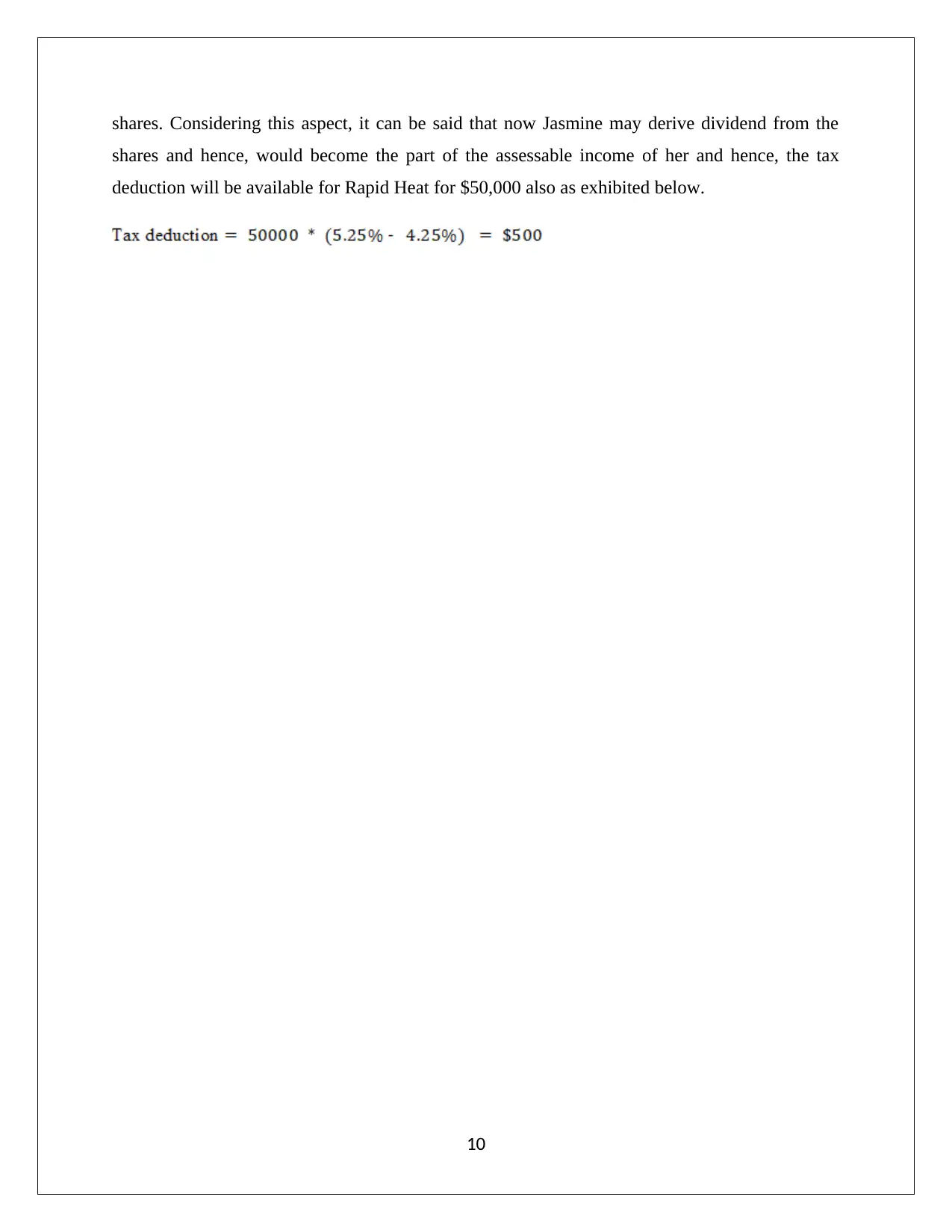
shares. Considering this aspect, it can be said that now Jasmine may derive dividend from the
shares and hence, would become the part of the assessable income of her and hence, the tax
deduction will be available for Rapid Heat for $50,000 also as exhibited below.
10
shares and hence, would become the part of the assessable income of her and hence, the tax
deduction will be available for Rapid Heat for $50,000 also as exhibited below.
10
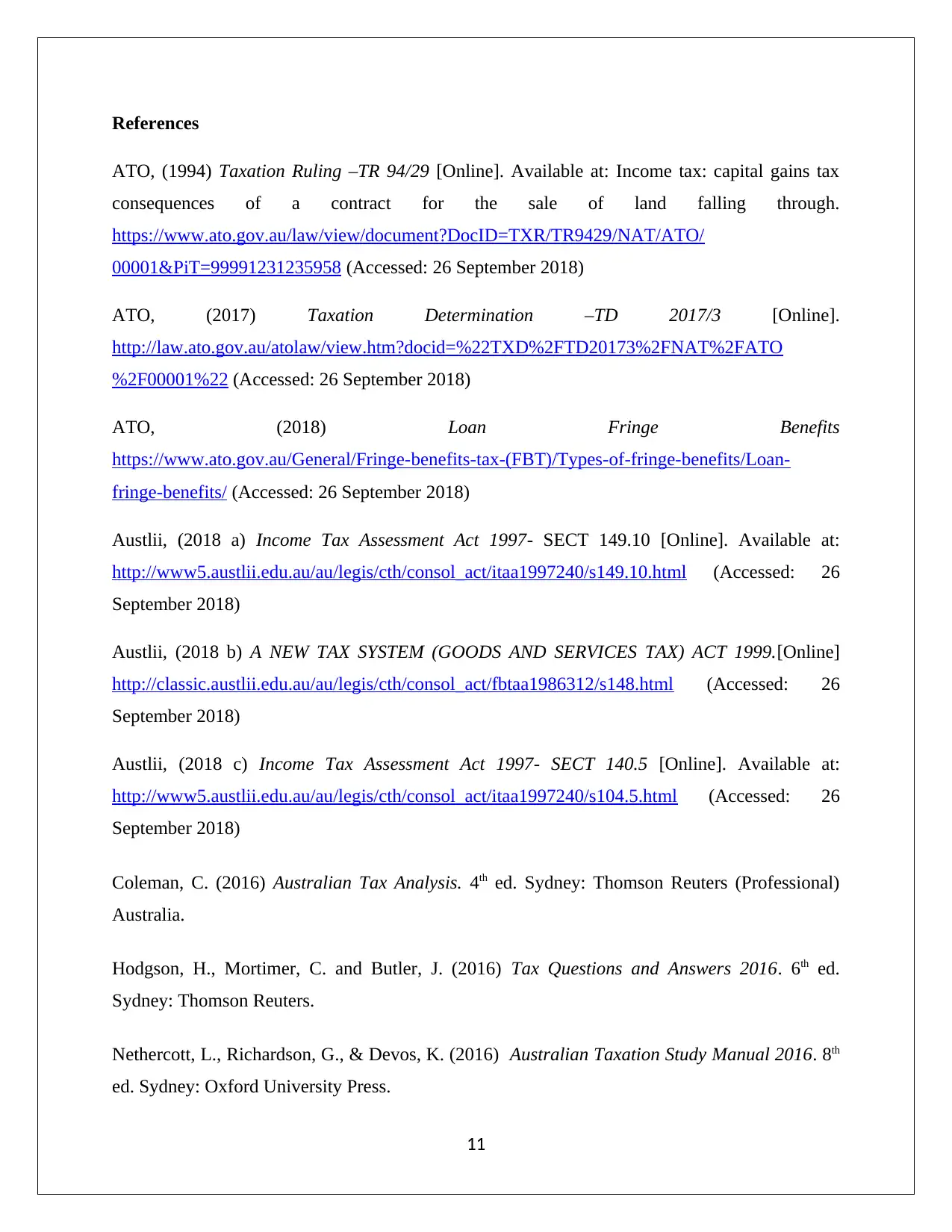
References
ATO, (1994) Taxation Ruling –TR 94/29 [Online]. Available at: Income tax: capital gains tax
consequences of a contract for the sale of land falling through.
https://www.ato.gov.au/law/view/document?DocID=TXR/TR9429/NAT/ATO/
00001&PiT=99991231235958 (Accessed: 26 September 2018)
ATO, (2017) Taxation Determination –TD 2017/3 [Online].
http://law.ato.gov.au/atolaw/view.htm?docid=%22TXD%2FTD20173%2FNAT%2FATO
%2F00001%22 (Accessed: 26 September 2018)
ATO, (2018) Loan Fringe Benefits
https://www.ato.gov.au/General/Fringe-benefits-tax-(FBT)/Types-of-fringe-benefits/Loan-
fringe-benefits/ (Accessed: 26 September 2018)
Austlii, (2018 a) Income Tax Assessment Act 1997- SECT 149.10 [Online]. Available at:
http://www5.austlii.edu.au/au/legis/cth/consol_act/itaa1997240/s149.10.html (Accessed: 26
September 2018)
Austlii, (2018 b) A NEW TAX SYSTEM (GOODS AND SERVICES TAX) ACT 1999.[Online]
http://classic.austlii.edu.au/au/legis/cth/consol_act/fbtaa1986312/s148.html (Accessed: 26
September 2018)
Austlii, (2018 c) Income Tax Assessment Act 1997- SECT 140.5 [Online]. Available at:
http://www5.austlii.edu.au/au/legis/cth/consol_act/itaa1997240/s104.5.html (Accessed: 26
September 2018)
Coleman, C. (2016) Australian Tax Analysis. 4th ed. Sydney: Thomson Reuters (Professional)
Australia.
Hodgson, H., Mortimer, C. and Butler, J. (2016) Tax Questions and Answers 2016. 6th ed.
Sydney: Thomson Reuters.
Nethercott, L., Richardson, G., & Devos, K. (2016) Australian Taxation Study Manual 2016. 8th
ed. Sydney: Oxford University Press.
11
ATO, (1994) Taxation Ruling –TR 94/29 [Online]. Available at: Income tax: capital gains tax
consequences of a contract for the sale of land falling through.
https://www.ato.gov.au/law/view/document?DocID=TXR/TR9429/NAT/ATO/
00001&PiT=99991231235958 (Accessed: 26 September 2018)
ATO, (2017) Taxation Determination –TD 2017/3 [Online].
http://law.ato.gov.au/atolaw/view.htm?docid=%22TXD%2FTD20173%2FNAT%2FATO
%2F00001%22 (Accessed: 26 September 2018)
ATO, (2018) Loan Fringe Benefits
https://www.ato.gov.au/General/Fringe-benefits-tax-(FBT)/Types-of-fringe-benefits/Loan-
fringe-benefits/ (Accessed: 26 September 2018)
Austlii, (2018 a) Income Tax Assessment Act 1997- SECT 149.10 [Online]. Available at:
http://www5.austlii.edu.au/au/legis/cth/consol_act/itaa1997240/s149.10.html (Accessed: 26
September 2018)
Austlii, (2018 b) A NEW TAX SYSTEM (GOODS AND SERVICES TAX) ACT 1999.[Online]
http://classic.austlii.edu.au/au/legis/cth/consol_act/fbtaa1986312/s148.html (Accessed: 26
September 2018)
Austlii, (2018 c) Income Tax Assessment Act 1997- SECT 140.5 [Online]. Available at:
http://www5.austlii.edu.au/au/legis/cth/consol_act/itaa1997240/s104.5.html (Accessed: 26
September 2018)
Coleman, C. (2016) Australian Tax Analysis. 4th ed. Sydney: Thomson Reuters (Professional)
Australia.
Hodgson, H., Mortimer, C. and Butler, J. (2016) Tax Questions and Answers 2016. 6th ed.
Sydney: Thomson Reuters.
Nethercott, L., Richardson, G., & Devos, K. (2016) Australian Taxation Study Manual 2016. 8th
ed. Sydney: Oxford University Press.
11
⊘ This is a preview!⊘
Do you want full access?
Subscribe today to unlock all pages.

Trusted by 1+ million students worldwide
1 out of 13
Related Documents
Your All-in-One AI-Powered Toolkit for Academic Success.
+13062052269
info@desklib.com
Available 24*7 on WhatsApp / Email
![[object Object]](/_next/static/media/star-bottom.7253800d.svg)
Unlock your academic potential
Copyright © 2020–2026 A2Z Services. All Rights Reserved. Developed and managed by ZUCOL.





